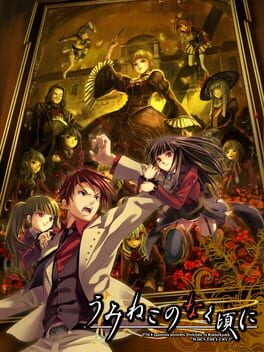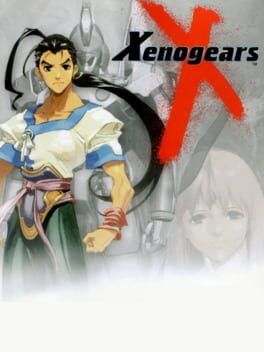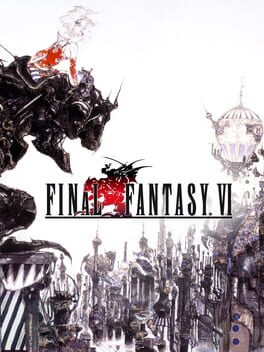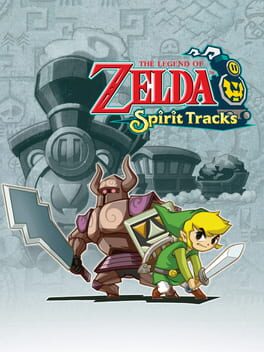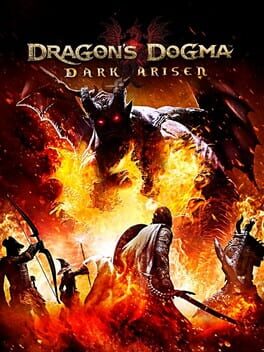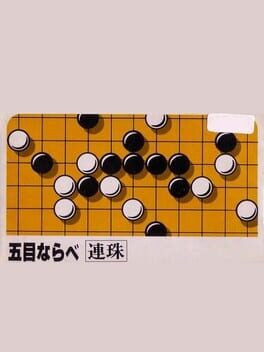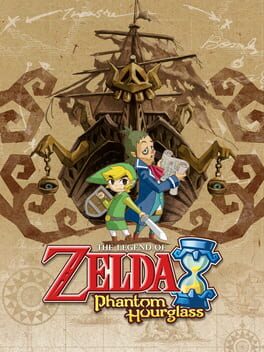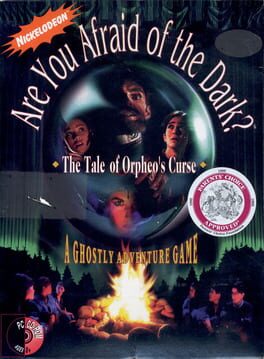Cadensia
BACKER
[On writing hiatus]
Historian specialised in gender studies and semiotics. Working on the representation of women in Japanese video game. She/her.
Although my reviews are generally written on the fly, I always try to discuss about game design and representation choices within a historical, literary and/or socio-cultural framework. Comparative study is an inquietude.
RPG, point-n-click, detective and adventure games nympholept.
–– Let my reviews teach you to be more interested in yourself than in them, then in everything else more than in you. ––
Badges

Listed
Created 10+ public lists

GOTY '23
Participated in the 2023 Game of the Year Event

1 Years of Service
Being part of the Backloggd community for 1 year

Gamer
Played 250+ games

Pinged
Mentioned by another user

Famous
Gained 100+ followers

Treasured
Gained 750+ total review likes

Donor
Liked 50+ reviews / lists

Full-Time
Journaled games once a day for a month straight

Trend Setter
Gained 50+ followers

Shreked
Found the secret ogre page

Adored
Gained 300+ total review likes

GOTY '22
Participated in the 2022 Game of the Year Event

Well Written
Gained 10+ likes on a single review

Popular
Gained 15+ followers

Loved
Gained 100+ total review likes

Best Friends
Become mutual friends with at least 3 others

Noticed
Gained 3+ followers

Gone Gold
Received 5+ likes on a review while featured on the front page

Liked
Gained 10+ total review likes

Roadtrip
Voted for at least 3 features on the roadmap

N00b
Played 100+ games

On Schedule
Journaled games once a day for a week straight
Favorite Games
315
Total Games Played
019
Played in 2024
023
Games Backloggd
Recently Played See More
Recently Reviewed See More
– Michiko Ishimure, Tenko, 1997 (tr. Bruce Allen).
The post-war years in Japan were accompanied by an ideological shift in the ideas of work and family, with the development of the sarariiman myth. The ideal household, promoted by the Japanese government, was one in which the wife took care of the housework and the children's education, while the husband provided for the family's economic needs. This dream was made possible by the employment conditions of the 1960s and 1970s, when the average worker could expect to spend their entire career with the same company. Representations of the Japanese sarariiman have largely evolved over time, making him both an archetype of ideal masculinity through his loyalty to his employer and his sacrifice for his family (kigyō senshi, corporate warrior). At the same time, other representations emphasise his submissiveness, in line with the westernisation of Japanese culture [1].
And every morning the door closes
The collapse of the economic bubble in the 1990s shattered this ideal, weakening the labour market and the salaried middle class [2]. The destruction of this family harmony, based on a patriarchal concept of sacrifice, led to the dysfunction of Japanese households and the gradual disappearance of fathers from the family unit. The generation born after the 1970s had no memory of the economic miracle of previous decades and found themselves thrust into a world where inequalities were apparent from school and career prospects were mediocre at best. Authority figures were viewed with suspicion and contempt, including the government, teachers and parents. They are said to have failed in their role as guardians: teachers are portrayed as incompetent or murderers, politicians as indifferent to misery and colluding to steal public money, while fathers resign and mothers weep at their powerlessness [3].
The destruction of traditional masculinity, which is still struggling to build a new mythology, has been followed by a reassessment of the place of women, who are regarded as the driving force for Japan's economic recovery and the bulwark against demographic decline. Unsurprisingly, Shinzo Abe's economic programme has focused heavily on the role of women, both as workers and as mothers. Yet Abenomics have failed to transform the labour market environment: government coalitions have been largely conservative, and measures for women have been anemic at best [4]. What remains is a vain discourse to encourage reproduction – despite the economic conditions hardly being met for raising a child – which is reflected in cultural production.
Undoing ikumen in post-Abe Japan
The overrepresentation of motherhood, however, should not obscure the transformations of fatherhood in the 2000s and 2010s. Xenoblade Chronicles 3: Future Redeemed is a striking example as it deals directly with this issue, whereas the original game looked at the question of reproduction and family in a broader way [5]. The heroes of the first two games return, each embodying a different vision of masculinity. Shulk retains his candour while appearing more calm and disciplined. He represents a self-controlled masculinity driven by both elegance and intellect, in the style of the erudite warriors of pre-modern Asia. Rex is much rougher, constantly struggling to find a way to express his feelings and frustrations, despite his good intentions. In some ways, his development is reminiscent of that of Ryōta Nonomiya in Hirokazu Kore-eda's Soshite chichi ni naru (2013), an architect who is unable to provide emotional comfort to his family. Confronted with the way Shulk interacts with Nikol, Rex finds a new harmony with Glimmer, full of empathy and love.
Perhaps the most important aspect of these relationships is that their nature remains implicit. Many of the reminiscent and contemplative passages in Future Redeemed rely on knowledge of the franchise, but the theme of fatherhood runs throughout the DLC. Ultimately, the heroes' distance from their children is a response to the debates surrounding ikumen, a term used to describe fathers who are involved in raising their children in order to make them appear 'cool'. The ideological programme of Abe's Japan relied heavily on this imaginary to encourage fathers to participate in the household, but the figure of the ikumen has been widely criticised for giving men a nice label, even though they contribute to the dysfunction of both the domestic economy and their working environment [6].
The figure of the ikumen can be understood as a way for fathers to make themselves useful somewhere and gain recognition from their peers, a way to find a place to belong (ibasho) after being ejected from both the family unit and the corporate space. Future Redeemed responds to this sociological question in the same way as several local associations have done, through the figure of the ikimen, men who decide to foster communities of solidarity in the same way that they would look after their children [7]. Shulk and Rex, thanks to their experience, become the tutelary figures of the Liberators and Colony 9, but they are more interested in being mentors than leaders. Like the base game, Future Redeemed focuses on building bonds between the various members of the community until their resilience is no longer in doubt. As the various characters point out to Matthew, the virtue of a leader is to bring people together when necessary, not to control their lives. Through the various side-quests, the inhabitants of Colony 9 also gain texture and individuality, autonomy and confidence – more so than in the base game, thanks to a sparser cast.
Maybe tomorrow
There is an optimistic melancholy to Future Redeemed, between the series' various iconic locations reduced to lonely ruins and the forward-looking language of the characters. Like Tetsuya Takahashi's other games, the DLC shines by magnifying the ties that bind individuals, variations on the theme of friendship, love and togetherness – lessons that must be carried beyond the game. A single existence is but a drop in the ocean of human history. Civilisations, buildings, masterpieces, passions, dreams and memories can vanish in an instant, but there remains an explicit duty to cherish the past, not in blind adoration, but in preparation for the future. Future Redeemed constantly refuses to elevate Shulk and Rex onto a pedestal: they are already fading figures, as their injuries attest. Even A, for all her unwavering calm and penetrating gaze, chooses to remain outside the life that Colony 9 and the Liberators have decided to cherish; not because she is without compassion for the survivors, but because she knows – and this is her legacy – that the future belongs to them alone.
As Xeno veterans know, every story has an ending, and not all sequels need to be told. Looking back at Lost Jerusalem and thinking about building a better world is poignant, but this is the everyday story. Fighting for a fairer and more humane world. It may take generations, but the important thing is to keep dreaming and struggling for it, because there is nothing more tragic than an existence without hope, even when darkness seems to engulf everything. Of course, there is something idealistic and simplistic about this statement, but Future Redeemed, like the base game Xenogears (1998) or Xenosaga (2002-2006), leaves room for misery and sadness. Inequality is part of every society, and Takahashi has no illusions about the ghosts that will always roam the Rhadamanthus of the future. This is how Future Redeemed concludes the epic of the Xenoblade Chronicles, just as Episode III: Also sprach Zarathustra (2006) invited one to close their eyes for a while, until the light of hope reappears, maybe tomorrow. In a way, Future Redeemed is just an open door. Its more meticulous progression with Affinity Points, its more fluid exploration thanks to numerous ergonomic additions, and its gameplay designed around accessories rather than classes all point to rich ideas for Monolith Soft's next projects.
I may still be around to see what paths they take.
Maybe I won't.
I will sleep a while, until the dawn wakes me up again...
I still believe... come what may...
__________
[1] Annette Schad-Seifert, 'Samurai and Sarariiman: The Discourse on Masculinity in Modern Japan', in Arne Holzhausen (ed.), Can Japan Globalize? Studies on Japan's Changing Political Economy and the Process of Globalization, Springer, Berlin, 2001, pp. 206-208.
[2] Some contextual details are provided in my reviews of Kaze no NOTAM (1997) and Power Shovel (1999).
[3] This is a rather simplified picture of the cultural representations of the 1990s and 2000s, but they occupy an important part of successful audiovisual production in Japan. On the topic, see Shuk-ting Kinnia Yau, 'Bad Father and Good Mother: The Changing Image of Masculinity in Post-Bubble-Economy Japan', in David G. Hebert (ed.), International Perspectives on Translation, Education and Innovation in Japanese and Korean Societies, Springer, New York, 2018, pp. 243-253.
[4] Mark Crawford, 'Abe’s Womenomics Policy, 2013-2020: Tokenism, Gradualism, or Failed Strategy?', in The Asia-Pacific Journal, vol. 19, no. 4-4, 2021.
[5] On the topic, see my review of Xenoblade Chronicles 3 (2022).
[6] In particular, wives and employers are very suspicious of the ikumen modoki, the father who prides himself on being involved in running the household and bringing up the children, but in reality makes no effort at all. He builds a positive image of himself on his wife's efforts and uses the household as an excuse to shirk his professional responsibilities. The yarisugi ikumen, the man who is overly proactive in his domestic involvement, is equally feared by women, both because he often disrupts household routines and wastes time, unnecessarily burdening his spouse with additional work. On the topic, see Nicholas Michael Feinig, Rearing the Family, Moving Society: Rethinking Gender, Kinship, and Work through Japan’s Fathering Movement, PhD thesis, University of Toronto, 2020, pp. 99-134.
[7] This figure is also subject to specific criticisms, notably the contamination of spaces intended for women by a corporatist and hierarchical masculinity, and the fact that these groups are more places for fathers to socialise than spaces for improving local community life; nevertheless, they are a new ibasho for men, outside the workplace. On the topic, see Nicholas Michael Feinig, op. cit., pp. 230-276.
Evoking the quirky spirit of LucasArts' point-and-click titles, No Rest for the Wicked is an intelligent adventure that strikes a subtle balance between inspiration, reference and its own identity. The plot and structure borrow directly from the first act of The Secret of Monkey Island (1990), reusing timed puzzles or reinterpreting the iconic verbal jousts through three different objectives. The initial puzzle is very similar to the one behind the tavern at the very start of the game, while the bookcase is a rather ingenious reinvention of the sword duels. The dialogue and the introductory cutscene are written with the same light-hearted, gently sarcastic glibness that characterised the Monkey Island series, with a protagonist forced into bizarre situations against their will. Similarly, the title takes the liberty of constantly breaking the fourth wall or mentioning elements that the characters are not supposed to know about, including fairly direct references such as Metallica's 'Master of Puppets' (1986).
Rather than taking sterile inspiration from a design that is sometimes more obtuse than it needs to be, No Rest for the Wicked manages to keep its puzzles in confined spaces, while making it easy to experiment with the objects. No pixel-hunting is required, as the cursor adapts contextually to the correct action. Although some may feel that the solutions are sometimes too explicitly given to the player, No Rest for the Wicked is more about creating an atmosphere than just mimicking old games. In a way, the title is emblematic of a recent trend in point-and-click games, which contrasts with the heaviness of titles by Wadjet Eye Games, Faravid Interactive and, more generally, games that border on detective stories - which are longer and coloured by a slightly pessimistic or melancholy view of the world. On the contrary, No Rest for the Wicked is a defence of shorter titles, infused with intelligent, respectful wit.
Between the 1960s and the 1980s, audiovisual horror production gradually tended towards family films and series. Such an approach was not necessarily obvious, as horror – and its iconic figures – were mainly used in fantastical, comic or didactic productions, without any explicit desire to frighten the viewer. Even in late-night series aimed at adults, such as Alfred Hitchcock Presents (1955), The Twilight Zone (1958) or Night Gallery (1970), horror was largely mixed with detective stories or speculative genres. The emergence of true children's television horror in the late 1980s can be explained by a number of factors: the publication of Scary Stories to Tell in the Dark (1981) by Alvin Schwartz frightened generations of American children with his gruesome reinterpretation of folk tales and urban legends. In particular, Stephen Gammell's disturbing, misshapen illustrations imposed a lasting aesthetic style, to the point where it became one of the books to provoke the most petitions for its withdrawal from libraries and schools [1]. Similar controversies arose when Gremlins (1984) and Robert L. Stine's Goosebumps (1992) were published.
At the same time, the development of cable television, much harder to regulate, created new problems. The television adaptation of Goosebumps (1995) was undoubtedly a product of the audiovisual capitalism of the 1990s, the aim of which was to sell books and various merchandise by creating visceral reactions in children – in other words, by genuinely scaring them. In contrast, Donald J. MacHale's Are You Afraid of the Dark? series (1990) deliberately employed the directorial codes popularised by Hitchcock – suspense rather than gore – and embedded its stories in a buffer zone. The diegetic existence of a Midnight Society, made up of imperfect American teenagers, serves to dilute the horror and cast the protagonists as heroes overcoming their fears [2].
The video game adaptation The Tale of Orpheo's Curse follows a similar spirit. Unlike titles like Phantasmagoria (1995) or Harvester (1996), the game is closer to Myst (1993) and The 7th Guest (1993). The player becomes the narrator of the story and is asked to make the right decisions to save Terry and Alex from the curse of the Orpheo Theatre. The setting is vast and it is easy to get lost between the various objectives: the horror comes from the time the player spends in slightly threatening environments, while being surveilled by the awkward eyes of wax statues. However, The Tale of Orpheo's Curse mitigates this aspect by allowing the player to interrupt the story and return to the Midnight Society's campfire, where various clues are given to the player. As in the series, this is a place to unwind, confirming the title's effective atmosphere and friendly disposition towards a relatively young audience.
There is something about the staging that always maintains the illusion of the story without resorting to violence or gore. The comic book-style visuals hide a lack of budget, but also serve to remind the player that this is fiction. These sequences, however, contrast with the chase scenes, which dramatically shifts the tempo of the exploration. While the premise is interesting, The Tale of Orpheo's Curse may be a little intimidating for younger audiences due to the cryptic nature of some of the puzzles – although they can be solved without too much difficulty thanks to the diegetic die-and-retry. The title even becomes a didactic tale: the Midnight Society points out that the story is a little too anti-climactic if the player manages to escape the theatre too quickly. In terms of creativity and narrative experimentation in an adventure game, The Tale of Orpheo's Curse, despite certain stylistic flaws, would have been well suited to the 3DO, alongside games like Psychic Detective (1995) or Lost Eden (1995), offering a unique and intelligent experience. Disappointingly, the title never received a sequel due to its poor commercial performance.
__________
[1] '100 most frequently challenged books: 1990-1999', on American Library Association, consulted on 6th October 2023.
[2] Jessica Balanzategui, 'Are You Afraid of the Dark?: Children’s Horror Anthology Series in the 1990s', in Adrian Schober, Debbie Olson (ed.), Children, Youth, and American Television, Routledge, London, 2018, pp. 208-211.
